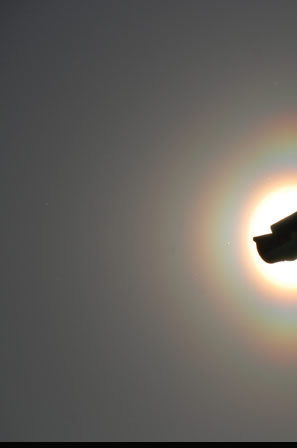A corona
from pollen dust imaged
by Eva Seidenfaden ~ "Paraselene" atmospheric
optics site ~ at
Trier, Germany May 12th '08.
©Eva Seidenfaden,
shown with permission.
Water drops are not essential to make a corona, the bright aureole
and rings we see around the moon or (when its bright disk
is well shielded) the sun. Pollen, coal or telescopes will do
equally.
Light waves scattered from the outsides of small
particles combine in a diffraction
pattern to make a corona. Therefore
the particles can be opaque.
Pollen grains shed in billions by spring trees produce excellent coronae.
Grains from a single tree variety are same-sized and hence their
coronae are sharp and multi-ringed. The grains have air sacs to help
disperse them and these orient each grain. The result
is anisotropic scattering and oval
rings with bright areas.
Telescopes? Babinet's Principle predicts that an aperture of the
same shape as an obstruction produces the same diffraction pattern.
The tiny star Airy disks seen under high magnification are
in-effect corona produced by the circular telescope aperture. |


